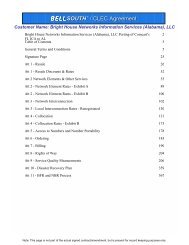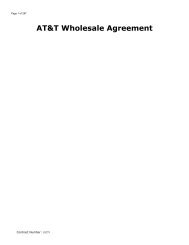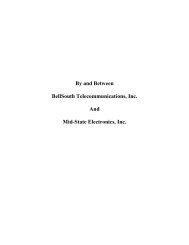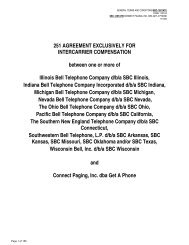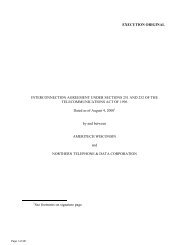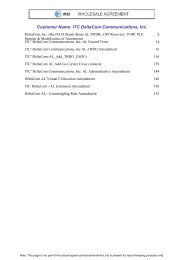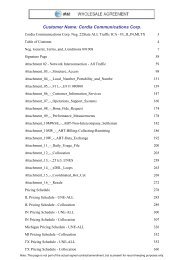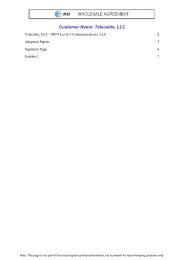AT&T Wholesale Agreement - AT&T Clec Online
AT&T Wholesale Agreement - AT&T Clec Online
AT&T Wholesale Agreement - AT&T Clec Online
You also want an ePaper? Increase the reach of your titles
YUMPU automatically turns print PDFs into web optimized ePapers that Google loves.
Page 58 of 94<br />
Attachment 02 – Network Interconnection/AT&T LOUISIANA<br />
Page 11 of 18<br />
Cricket Communications, Inc.<br />
Version: 3Q08 – Two-Way CMRS ICA – Wireless 02/12/09<br />
3.5.9 Trunk requirements for forecasting and servicing shall be based on the blocking objectives shown in Table 2<br />
below. Trunk requirements shall be based upon time consistent average busy season busy hour twenty<br />
(20) Day averaged loads applied to industry standard Neal-Wilkinson Trunk Group Capacity algorithms (use<br />
Medium day-to-day Variation and 1.0 Peakedness factor until actual traffic data is available) for all final<br />
Trunk Groups.<br />
Table 2<br />
Trunk Group Type Design Blocking Objective<br />
Type 2A 1%<br />
Type 2A Equal Access (IXC) 1%<br />
Type 2B (Final) 1%<br />
Type 2C (911) 1%<br />
Type 2D (Operator Services<br />
(DA/DACC))<br />
1%<br />
Type 1 (Operator Services (0+, 0-)) 1%<br />
3.5.10 When Trunks exceed measured blocking thresholds on an average time consistent busy hour for a twenty<br />
(20) business day study period, the Parties shall cooperate to increase the Trunks to the above blocking<br />
criteria in a timely manner. The Parties agree that twenty (20) business days is the study period duration<br />
objective.<br />
3.6 Routing And Rating:<br />
Page 58 of 105<br />
3.6.1 Each WSP NPA-NXX must have a single Rating Point, and that Rating Point must be associated with a<br />
Rate Center, as defined in the applicable AT&T LOUISIANA landline state tariff, and as entered into the<br />
LERG. The geographical exchange area of the associated Rate Center must be served by an End Office<br />
Switch or other End Office Switches sub-tending the AT&T LOUISIANA Tandem Office Switch, where a<br />
Type 2A Trunk Group is located, or the End Office Switch where a Type 2B or Type 1 Trunk Group is<br />
located. The Rating Point may be designated anywhere in the LATA, when the Commission so rules in a<br />
proceeding binding AT&T LOUISIANA. The Rating Point does not have to be the same as the Routing<br />
Point.<br />
3.6.2 Each NPA-NXX assigned to WSP with a Rate Center outside the AT&T LOUISIANA franchise area must be<br />
entered into the LERG, such that (a) the NPA-NXX is accurately reflected as rated from the out-of-franchise<br />
Rate Center, and (b) the NPA-NXX is assigned to WSP’s serving switching entity or POI that is located<br />
inside the AT&T LOUISIANA franchise area, and (c) WSP’s switching entity, or POI serving the NPA-NXX,<br />
subtends or is homed on an AT&T LOUISIANA tandem.<br />
3.6.3 All terminating traffic delivered by WSP to a Tandem Office Switch destined for publicly dialable NPA-NXXs<br />
served by a switching entity that does not home on that Tandem Office Switch is misrouted. AT&T<br />
LOUISIANA shall provide notice to WSP, pursuant to the Notices provisions of this <strong>Agreement</strong> that such<br />
misrouting has occurred. In the notice, WSP shall be given thirty (30) days to cure such misrouting.<br />
3.6.4 The Parties shall deliver all traffic destined for the other Party’s network in accordance with the serving<br />
arrangements defined in the LERG or via the most direct route to avoid inter-tandem routing.<br />
3.6.5 For Type 2 Trunk Groups, i.e., Type 2A and Type 2B, WSP will obtain its own NXX codes from the<br />
administrator and will be responsible for: (a) LERG administration, including updates, and (b) all ASR/WSR<br />
Translations Questionnaire (“TQ”) Code opening information necessary for routing traffic on these Trunk<br />
Groups.<br />
3.6.6 AT&T LOUISIANA will not route traffic to WSP via a Third Party Tandem, however, WSP may route traffic to<br />
AT&T LOUISIANA via a Third Party Tandem where technically feasible.<br />
3.6.7 If either Party originates Section 251(b)(5) Calls destined for termination to the other Party, but delivers that<br />
traffic to the other Party using the Facilities of a Third Party Telecommunications Carrier, the terminating<br />
Party shall be entitled to charge transport and termination rates to the originating Party, as set forth in the



